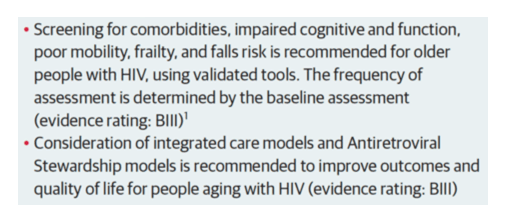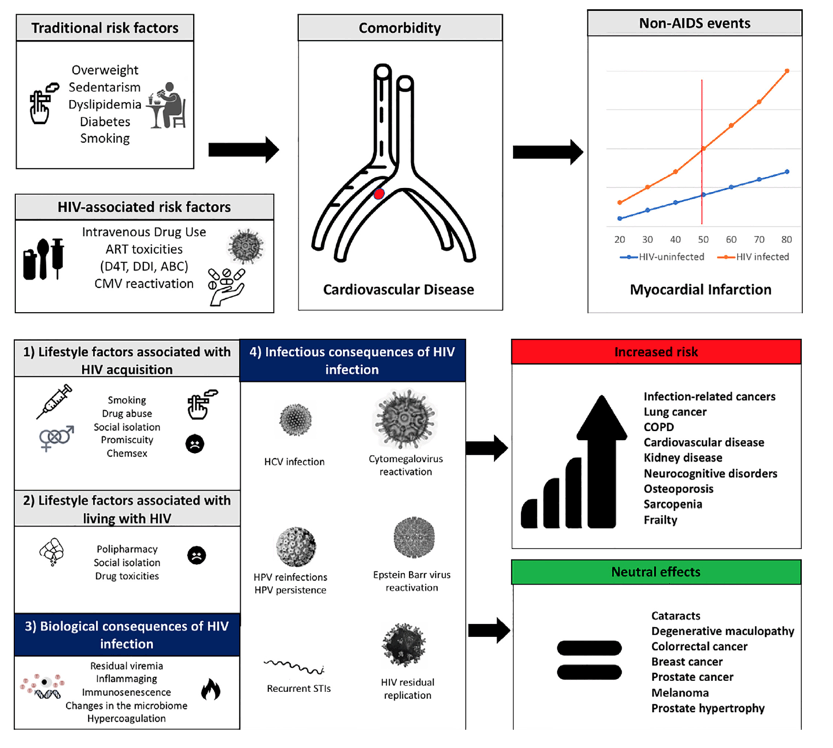| |
30 European HIV Specialists Review Aging/HIV Challenges, Recommendations
|
| |
| |
Download the PDF here
30 European HIV specialists wrote this paper on preparing for aging/elderly HIV population recommending "community-based, personalized, integrative and multidisciplinary delivery systems for lifelong care, with the participation of staff trained in both specialized HIV management and non-infectious comorbidities. We feel that the ability to reach the formidable goal of fully normalize the health of PLWH lies ahead of us.".
Management of Comorbidities in Treated HIV Infection: A Long Way to Go: HIV, comorbidities and aging
Javier Martínez-Sanz a, b, ∗, §, Sergio Serrano-Villar a, b, ∗, §§, María Jesús Vivancos a, b,
Rafael Rubio b, c, Santiago Moreno a, b , on behalf of the HIV-associated comorbidities Study Group
a Department of Infectious Diseases. University Hospital Ramón y Cajal and IRYCIS, Universidad de Alcalá, Madrid, Spain
b CIBER de Enfermedades Infecciosas
c Department of Internal Medicine. University Hospital Doce de Octubre, Universidad Complutense, Madrid, Spain
Funding: This project was supported by Gilead Sciences by a restricted grant for the study. This company did not participate in the selection of the experts involved in the discussions or in the content of this manuscript.
attached
APPENDIX 1. List of HIV specialists participating in the meetings regarding the management of comorbidities in treated HIV.
APPENDIX 2. Specific questions
HIGHLIGHTS
• The focus of clinical research has shifted from AIDS-defining to non-AIDS defining illnesses.
• The influence of cumulative toxicities from modern ART in the development of comorbidities are now at a minimum.
• Progress is being made in understanding the different impact of antiretroviral regimens on chronic inflammation. We can expect that the influence of chronic inflammation on the development of comorbidities will decrease in the future.
• The negative impact of comorbidities on the patient's quality of life is far beyond that of HIV infection itself and therefore HIV specialists often find themselves acting as general practitioners.
• Drug-to-drug interactions have become one of the main problems in the clinical management of patients with HIV infection.
Currently, we are confronted with the formidable challenge of normalizing the health of PLWH and creating a more comprehensive HIV management program. Here, we compile the opinions of a joint effort of 30 HIV specialists who reviewed the literature and debated the latest major challenges in the field of HIV-associated comorbidities and delineated future strategies to fully normalize health in HIV. Six key questions are answered and developed, such as the relevance of comorbidities in the management of HIV-infected patients, their drivers, management, prevention strategies, and possible evolution in the future.
------------------------------
Early Onset of Comorbidities by 7-24 Years in PLWH in Large Healthcare System in USA, Kaiser Permanente
https://www.natap.org/2020/HIV/marcus_2020_oi_200340(1).pdf
New HIV Guidelines IAS-USA Panel; Aging, Weight - (12/01/22)

-------------------------------
Here, we compile the opinions of a joint effort of 30 HIV specialists who reviewed the literature and debated the latest major challenges in the field of HIV-associated comorbidities and delineated future strategies to fully optimize health in HIV.
------------------------------
1. We face the tremendous challenge of designing sustainable, community-based, personalized, integrative and multidisciplinary delivery systems for lifelong care, with the participation of staff trained in both specialized HIV management and non-infectious comorbidities. We feel that the ability to reach the formidable goal of fully normalize the health of PLWH lies ahead of us.
2. We think both the HIV specialist and the primary care physician should co-supervise the prevention and screening of comorbidities in PLWH and only refer to other specialists for the management of complex conditions. The ideal solution could include HIV specialists centralizing the care and supervising multidisciplinary teams, alongside routine follow-up visits with general practitioners specifically trained in HIV medicine. We think that the risk of comorbidities will be mainly influenced by risk factors associated with HIV acquisition, such as sexual risk behaviors, drug use or socio-economic status.
3. chronic obstructive pulmonary disease (COPD) is now the main cause of hospitalization worldwide and is likely to be underdiagnosed in HIV patients.
4. While HIV can be treated with one single tablet and one annual follow-up visit [25,26], the presence of comorbidities dictates that many patients cannot adhere to this plan, with additional evaluations, multiple specialist consultations and polypharmacy warranted.
5. early and fully suppressive ART is likely to be the most successful preventive intervention.
6. the only intervention, shown to significantly decrease markers of systemic inflammation in most, but not all, studies in PLWH is aerobic exercise [64–67].
7. HIV-infected persons could benefit from specific programs, such as lung cancer screening by performing low-radiation chest CT scanning [48], as well as anal cytology in persons with sexual risk factors, although there is still no robust evidence of its benefit [26].
8. reduction in the threshold for a statin prescription would benefit PLWH.
9. such as colon cancer screening in people over 50 years old or osteoporosis screening in post-menopausal women, are also advocated in clinical guidelines for the management of HIV infection [49].
10. high-resolution anoscopy for the screening of precancerous anal lesions is being incorporated into many HIV management programs yet any benefit of this intervention remains to be determined.
11. It is likely that the negative impact of comorbidities on the patient's quality of life is far beyond that of HIV infection itself and therefore HIV specialists often find themselves acting as general practitioners for their patients. The prescription of drugs to treat comorbidities may influence the choice of ART regimens and warrants a cautious evaluation of drug-to-drug interactions, adding complexity to clinical evaluations. Hence, the presence of comorbidities complicates the clinical evaluation, increases the number of follow-up consultations required and entails further input from different specialists outside the HIV field.
12. preventive and screening procedures should be emphasized in this vulnerable population [31]. However, more information on the cost-effectiveness of screening procedures in treated HIV patients is needed to ensure successful implementation. Third, the risk of drug-to-drug interactions and the fact that HIV infection has classically been an exclusion criterion in many clinical trials evaluating the efficacy of drugs for the treatment of different conditions [32], strongly influences the treatment of comorbidities.
13. Given that the risk of comorbidities is not homogeneous even within the HIV treated population, in terms of epidemiology, risk assessment, management and prevention, more susceptible patients would benefit more from targeted interventions. For example, specific programs could be prioritized in subjects with a greater prevalence of classical risk factors (e.g., smoking or intravenous drug use, high estimated cardiovascular risk, recurrent STIs), greater immunological harm (low nadir CD4 cell count, CD4/CD8 ratio <0.4 [42], hsCRP >2mg/L) [43] or those exposed to more toxic ART regimens.
14. Lifestyle, disease action changes - Diet, exercise-physical activity, falls prevention, CVD prevention education, diabetes management control & education, cognitive improvement trainings
- Modification of the lifestyle factors associated with an increased risk of comorbidities should be pursued as the intervention with greatest potential benefit. Fighting tobacco use is a good example, since smoking reduces live expectancy in PLWH more than HIV itself.
- Moreover, polypharmacy is associated with worst reported outcomes, including non-adherence in the general population and increased risk of geriatric syndromes such as falls, fractures, and dementia in the elderly population.
- risk behaviors are likely to remain a major driver behind the development of comorbidities in the treated HIV population.
- smoking and injectable drug use, two major drivers of cardiovascular disease (CVD), have classically been more frequent in HIV-infected individuals.
- despite the fact that HIV infection has been proposed as a cardiovascular risk factor comparable to diabetes mellitus [36], only about half of patients requiring statins or aspirin are adequately treated [37],
15. Ongoing HIV replication in anatomical reservoirs is believed to sustain chronic immune dysfunction. This association appears particularly relevant in the central nervous system, in which persistent immune activation in relation with poor ART penetration correlates with neurocognitive impairment [11,12]. Additionally, many defects induced by HIV, for example lymphoid fibrosis and gut associated lymphoid tissue(GALT) destruction, are established very early following infection and are not restored despite early-initiated and long-term ART. These chronic immune abnormalities allow certain mechanisms such as cytomegalovirus chronic replication, dysbiosis or bacterial translocation to occur, which result in low-level inflammation, promote immunosenescence and ultimately leads to the development of comorbidities [14].

|
|
| |
| |
|
|
|